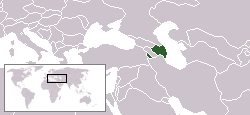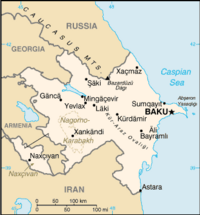Azerbaijan
|
|
Azerbaijan (Azerbaijani: Azərbaycan) is a country in the Caucasus, at the crossroads of Europe and Southwest Asia, with an eastern coast on the Caspian Sea. It has frontiers with Russia in the north, Georgia in the northwest, Armenia in the west, and Iran in the south. The Nakhichevan Autonomous Republic (an exclave of Azerbaijan) borders Armenia to the north and east, Iran to the south and west, and Turkey to the northwest.
The country’s formal name is the Republic of Azerbaijan (Azerbaijani: Azərbaycan Respublikası). Azerbaijan is a secular state, and has been a member of the Council of Europe since 2001. A majority of the population are Shia Muslim and of Western Turkic descent, known as Azerbaijanis, or simply Azeris. The country is formally an emerging democracy, however with strong authoritarian rule.
| |||||
| National motto: None | |||||

| |||||
| Official language | Azerbaijani | ||||
| Capital | Baku | ||||
| Capital’s coordinates | Template:Coor dm | ||||
| President | Ilham Aliyev | ||||
| Prime Minister | Artur Rasizade | ||||
| Area – Total – % water | Ranked 111th 86,600 km? Negligible | ||||
| Population – Total – Density | Ranked 89th 7,868,385 (July 2004 E) 90/km?. | ||||
| Independence – Date | From Soviet Union 30 August 1991 | ||||
| Currency | Manat (AZM) | ||||
| Time zone | UTC +4 (DST +5) | ||||
| National anthem | National Anthem of the Republic of Azerbaijan | ||||
| Internet TLD | .az | ||||
| Calling Code | 994 | ||||
| Contents |
Origin and history of the name
There are several hypotheses regarding the origins of the name "Azerbaijan." The most common theory is that it is derived from "Atropatan." Atropat was the satrap at the time of the Persian Achaemenid dynasty, and gained independence after Alexander the Great destroyed the Achaemenids. The region was known as Media Atropatia or Atropatene at the time.
There are also alternative opinions that the term is a slight Turkification of Azarbaijan, in turn an Arabicized version of the original Persian name Azarpayagan, made up of azar+payag+an (azar=fire; payag=base; an=suffix of location); that it traditionally means "the land of eternal flames" or "the land of fire." Some Azeri historians also contend that the name is made up of four Azerbaijani components: az+er+bay+can, which means "the land of the brave Az people" or "an elevated place for the wealthy and exalted."
Historically, the territory of the present-day Azerbaijan Republic, sometimes referred to as North Azerbaijan, has also been called Arran, named after Arran, a legendary founder of Caucasian Albania. However, the precise location identified by this name has shifted somewhat over time, currently referring to the lowland Karabakh plains situated between the Kura and Araks rivers.
Despite the demonstrable antiquity of the name, some opponents of the name Azerbaijan assert that it is anachronistic to use it in a historical context before 1918, because, they say, the term was first introduced by the national intelligentsia in early 20th century and later was endorsed by the Bolsheviks, with intention of claiming the northern province of Persia. To substantiate this claim they state that till early 20th century the population of present-day Azerbaijan had no clear ethnic identification and referred to themselves primarily as "Muslims."
History
Main article: History of Azerbaijan
Historically Azerbaijan has been occupied by a variety of peoples, including Persians, Romans, Arabs, Turks, Mongols and Russians.
The first state to emerge in the territory of present-day Republic of Azerbaijan was Mannae in the 9th century BC, lasting until 616 BC when it was overthrown by the Medes. The satrapies of Atropatene and Caucasian Albania were established in the 4th century BC and included the approximate territories of present-day Azerbaijan and southern parts of Dagestan.
Islam spread in Azerbaijan following the Arab conquests in the 7th–8th centuries. In the 11th century, the Seljuk Turks became the dominant force in Azerbaijan and laid the ethnic foundation of contemporary Azerbaijanis. In the 13–14th centuries, the country experienced Mongol-Tatar invasions.
Azerbaijan was part of the Safavid state in 15th–18th centuries. It also underwent a brief period of feudal fragmentation in the mid-18th to early 19th centuries, and consisted of independent khanates. Following the two wars between the Qajar dynasty of Persia and the Russian Empire, Azerbaijan was acquired by Russia through the Treaty of Gulistan in 1813, and the Treaty of Turkmenchay in 1828.
After the collapse of the Russian Empire during World War I, Azerbaijan declared independence and established the Azerbaijan Democratic Republic. This first Muslim republic in the world lasted only two years, from 1918 to 1920, before the Soviet Red Army invaded Azerbaijan. Subsequently, Azerbaijan became part of the Soviet Union.
Azerbaijan re-established its independence upon the collapse of the Soviet Union in 1991. Despite a cease-fire in place since 1994, Azerbaijan has yet to resolve its conflict with Armenia over the Azerbaijani Nagorno-Karabakh enclave (largely Armenian-populated). Azerbaijan has lost 16% of its territory, and must support some 800,000 refugees and internally displaced persons as a result of the conflict.
Politics
Main article: Politics of Azerbaijan
Azerbaijan is a presidential republic. The head of state and head of government are separate from the country’s law-making body. The people elect the president for a five-year term of office. The president appoints all cabinet-level government administrators. A fifty-member national assembly makes the country’s laws. The people of Azerbaijan elect the National Assembly. Azerbaijan has universal suffrage above the age of eighteen. However, the Azerbaijani government has been accused of widespread corruption (a kleptocracy, according to some people).
Administrative divisions
Main article: Administrative divisions of Azerbaijan
Azerbaijan is divided into:
- 59 rayons (rayonlar; rayon – singular),
- 11 cities* (şəhərlər; şəhər – singular),
- 1 autonomous republic** (muxtar respublika);
Absheron Rayonu, Agjabedi Rayonu, Agdam Rayonu, Agdash Rayonu, Agstafa Rayonu, Agsu Rayonu, Ali Bayramli Sahari*, Astara Rayonu, Baku Sahari*, Balakan Rayonu, Barda Rayonu, Beylaqan Rayonu, Bilasuvar Rayonu, Jabrayil Rayonu, Calilabad Rayonu, Dashkasan Rayonu, Davaci Rayonu, Fizuli Rayonu, Gadabay Rayonu, Ganja Sahari*, Goranboy Rayonu, Goychay Rayonu, Hajigabul Rayonu, Imishli Rayonu, Ismayilli Rayonu, Kalbajar Rayonu, Kurdamir Rayonu, Lachin Rayonu, Lankaran Rayonu, Lankaran Sahari*, Lerik Rayonu, Masalli Rayonu, Mingechevir Sahari*, Naftalan Sahari*, Nakhichevan Autonomous Republic**, Neftchala Rayonu, Oguz Rayonu, Gabala Rayonu, Gakh Rayonu, Gazakh Rayonu, Gobustan Rayonu, Guba Rayonu, Gubadly Rayonu, Gusar Rayonu, Saatli Rayonu, Sabirabad Rayonu, Sheki Rayonu, Sheki Sahari*, Salyan Rayonu, Shamakhy Rayonu, Shamkir Rayonu, Samux Rayonu, Siyazan Rayonu, Sumqayit Sahari*, Shusha Rayonu, Shusha Sahari*, Tartar Rayonu, Tovuz Rayonu, Ujar Rayonu, Khachmaz Rayonu, Khankendi Sahari*, Khanlar Rayonu, Khizi Rayonu, Khojaly Rayonu, Khojavend Rayonu, Yardimli Rayonu, Yevlakh Rayonu, Yevlakh Sahari*, Zangilan Rayonu, Zagatala Rayonu, Zardab Rayonu.
Geography
Main article: Geography of Azerbaijan
Azerbaijan has an arid climate, except in the southeast near Gilan. Temperatures vary by season. In the southeast lowland, temperatures average 6°C (43°F) in the winter and 26°C (80°F) in the summer — though daily maxima typically reach 32°C (89°F). In the northern and western mountain ranges, temperatures average 12°C (55°F) in the summer and –9°C (20°F) in the winter.
Annual rainfall over most of the country varies from 200 to 400 mm (8 to 16 inches) and is generally lowest in the northeast. In the far southeast, however, the climate is much moister and annual rainfall can be as high as 1300 mm (51 inches). For most of the country, the wettest periods are in spring and autumn, with summers being the driest.
Economy
Main article: Economy of Azerbaijan
The economy is largely based on industry. Industries include machine manufacture, petroleum and other mining, petroleum refining, textile production, and chemical processing. Agriculture accounts for one-third of Azerbaijan’s economy. Most of the nation’s farms are irrigated. In the lowlands, farmers grow such crops as cotton, fruit, grain, tea, tobacco, and many types of vegetables. Silkworms are raised for the production of natural silk for the clothing industry. Azerbaijan’s herders raise cattle, sheep and goats near the mountain ranges. Seafood and fish are caught in the nearby Caspian Sea. Azerbaijan has a highly dynamic economy, mainly because of oil, and has a GDP growth rate of up to 11% a year.
Demographics
Main article: Demographics of Azerbaijan
According to the CIA World Factbook, about eighty-nine percent of Azerbaijan’s population is ethnic Azerbaijani, or Azeris. Other major ethnicities include local Talysh, Lezgi, Avar and Tat and numerous other minorities, as well as Russians. Some people argue that the number of Talysh is more than officially recorded, as many of them are counted as Azerbaijanis. The country’s large Armenian population mostly fled to Armenia and to other countries with the beginning of the Armenian-Azeri conflict over Nagorno-Karabakh. During the same period, Azerbaijan also received a large influx of Azerbaijanis fleeing Armenia and later Nagorno-Karabakh and adjacent provinces occupied by the Armenians.
Most Azerbaijanis, or Azeris, are Shia Muslim. Other religions or philosophical beliefs that are followed by many in the country are the Sunni and Sufi sects of Islam, the Armenian Apostolic Church, the Russian Orthodox Church, and various secular beliefs (many of which are left over from the Soviet era of less tolerance for spirituality).
Culture
Main article: Culture of Azerbaijan
The official language of Azerbaijan is Azerbaijani, a member of the Oguz subdivision of the Turkic language family, and is spoken by around 95% of the republic’s population, as well as about a quarter of the population of Iran. Its closest relatives are Turkish and Turkmen. As a result of the language policy of the Soviet Union, Russian is also commonly spoken as a second language among the urbane.
Miscellaneous topics
- Communications in Azerbaijan
- Transportation in Azerbaijan
- Military of Azerbaijan
- Foreign relations of Azerbaijan
- Public holidays in Azerbaijan
- List of Azerbaijanis
- Nagorno-Karabakh
External links and references
- CIA World Factbook — Azerbaijan (http://www.cia.gov/cia/publications/factbook/geos/aj.html)
- BBC Country Profile: Azerbaijan (http://news.bbc.co.uk/1/hi/world/europe/country_profiles/1235976.stm)
- Azerbaijan from A to Z (http://www.azerb.com/)
- Virtual Azerbaijan Republic (http://www.zerbaijan.com/)
- Caucaz.com (http://www.caucaz.com/home_uk): Weekly online publishing articles and reports about Azerbaijan and South Caucasus. Available in English and French
- Baku Today (http://www.bakutoday.net)
- President of the Republic of Azerbaijan (http://www.president.az/index_e.html)
- State Statistical Committee of the Azerbaijan Republic (http://www.azstat.org/indexen.php)
- United Nations Office in Azerbaijan (http://www.un-az.org) with a country report (http://www.un-az.org/couinf.htm)
- Library of Congress Portals on the World — Azerbaijan (http://www.loc.gov/rr/international/amed/azerbaijan/azerbaijan.html)
- Azerbaijan Travel Services (http://bakuservices.com)
- Azerbaijan Paper Money (http://numismondo.com/pm/aze/): Issues from the Russian, Iranian and Autonomous Republic periods as well as current Republic issues
| Countries in Europe |
|---|
| Albania | Andorra | Austria | Azerbaijan1 | Belarus | Belgium | Bosnia and Herzegovina | Bulgaria | Croatia | Cyprus2 | Czech Republic | Denmark | Estonia | Finland | France | Germany | Greece | Hungary | Iceland | Ireland | Italy | Latvia | Liechtenstein | Lithuania | Luxembourg | Macedonia | Malta | Moldova | Monaco | Netherlands | Norway | Poland | Portugal | Romania | Russia1 | San Marino | Serbia and Montenegro | Slovakia | Slovenia | Spain | Sweden | Switzerland | Turkey1 | Ukraine | United Kingdom | Vatican City |
| Dependencies: Akrotiri and Dhekelia2 | Faroe Islands | Gibraltar | Guernsey | Jan Mayen | Jersey | Isle of Man | Svalbard |
| 1. Country partly in Asia. 2. Usually assigned to Asia geographically, but often considered European for cultural and historical reasons. |
| Countries and Territories in Southwest Asia |
|
Afghanistan | Armenia | Azerbaijan | Bahrain | Cyprus | Gaza Strip | Georgia | Iran | Iraq | Israel | Jordan | Kuwait | Lebanon | Oman | Qatar | Russia | Saudi Arabia | Syria | Turkey | United Arab Emirates | West Bank | Yemen |
| Commonwealth of Independent States (CIS) | 
|
| Armenia | Azerbaijan | Belarus | Georgia | Kazakhstan | Kyrgyzstan | Moldova | Russia | Tajikistan | Turkmenistan | Ukraine | Uzbekistan | |



